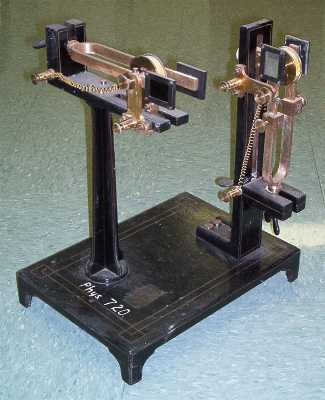Lissajous Figures were first described in 1815 by Nathaniel Bowditch (1773-1838), who is best known today for his book, "The New American Practical Navigator", still available today. He also wrote widely on mathematics and astronomy, while pursuing a career as a navigator, surveyor, actuary and insurance company president, as well as being a member of the Corporation of Harvard College.
| The optical production of the curves was first demonstrated in 1857 by Jules Antoine Lissajous (1833-1880), using apparatus similar to that at the left. Today we can do the same experiment more easily with a laser beam that reflects from the two mirrors vibrating at right angles to each other and then traces the Lissajous figure on the wall. |
|
The pair of tuning forks at the right
is at St. Patrick's College in Maynooth, County Kildare, Ireland. They were
made by Yeates & Son of Dublin in the second half of the 19th century.
The parallel mountings suggests that these forks could also be used to demonstrate
beats.
On the left is a pair of tuning forks permanently mounted at
right angles to each other. The apparatus is shown in the 1900 catalogue of
Max Kohl at a price of 66 Marks. It is in the collection at St. Mary's College
in Notre Dame Indiana.
The frequency of the tuning forks in both sets of apparatus can be varied by sliding masses up and down. |
| The very heavy piece of cast-iron apparatus at the right
sits in my living room, where it menaces the unwary toe. Both tuning forks
can be driven, allowing steady-state Lissajous figures to be displayed. At
the back is a device once used to hold a light source, and a previous owner
has mounted a lens on the base of the device. The light source system can
be moved right and left with a crank system.
This apparatus, without the light-source holder, is listed at 195 Marks in the 1900 catalogue of Max Kohl of Chemnitz, Germany. Another device that relies on Lissajous Figures is the Tune Analyzer made by Newton & Co. of London. |
| Another Max Kohl device for producing Lissjous figures is at the left. Both tuning forks are electrically driven, and two additional forks of different frequencies are hanging on the rear side of the apparatus, This demonstration is in the collection of Hobart and William Smith Colleges of Geneva, New York, and was bought in the late 1920s. |
|
| The Lissajous figure demonstration device at the left was
made by the firm of Ferdinand Ernicke of Berlin.
Like the two pieces of Kohl apparatus above, it uses two tuning forks vibrating at right angles to each other, with a beam of light being reflected from mirrors attached to the ends of the tuning forks. The device is in the collection of the University of Arkansas physics department, and probably dates from about 1900. It is of the order of 30 to 35 cm in height. |

|
| At the left is Stöhrer's apparatus for projecting Lissajous
Figures. As the crank is turned, the two rods move in simple harmonic motion
at right angles to each other. The circular masks at the ends of the rods
contain slots. Consequently, the hole formed by the intersection of the two
perpendicular slots traces out a Lissajous figure. The figures are shown
by projection, with a point source of light (originally an arc lamp) casting
a enlarged replica of the motion of the intersection on a distant wall.
Different figures can be traced out by using different gear wheels that are in contact with the toothed edge of the large wheel. The apparatus is listed in the 1900 Max Kohl catalogue at 83 Marks. This example is at Dartmouth College; an identical machine is in the collection of the National Museum of American History of the Smithsonian Institution. |
| George Hopkins described this Lissajous figure drawing device
at the beginning of the twentieth century. As the cut shows, it is designed
for use in a projection lantern, with a stylus tracing a clear path on a
smoked glass plate.
The two pendula are both pivoted at the same point. The right-hand pendulum drives the stylus (on the end of the counter-weighted horizontal bar) back and forth in simple harmonic motion, while the rod projecting horizontally from the left-hand pendulum moves the horizontal bar up and down in SHM. As usual, the periods of the two motions are adjusted by moving the weights up and down. |
|
|
Thomas B. Greenslade, Jr., "Nineteenth Century Textbook Illustrations,
XXVII...Harmonographs, Phys. Teach., 17, 256-8
(1979)
Thomas B. Greenslade, Jr. "Apparatus for Natural Philosophy: Nineteenth Century
Wave Machines", Phys. Teach., 18, 510-517 (1980)
George M. Hopkins, Experimental Science, Vol. II, Twenty-Seventh Edition
(Munn & Company, New York, 1911),
pp 127-129